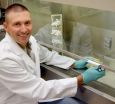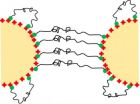(Press-News.org) A new strategy which enables molecules to be disconnected essentially anywhere, even remote from functionality, is described by researchers from the University of Bristol in Nature Chemistry today. The method is now being developed to explore the possibility of creating a tuberculosis (TB) vaccine.
The organic synthesis strategy, developed by Professor Varinder Aggarwal and Dr Ramesh Rasappan in the School of Chemistry, involves a new method for combining smaller fragments together in which there is no obvious history in the product of their genesis.
The paper describes not only this new strategy, but also its application to the shortest known synthesis, just 14 steps, of hydroxyphthioceranic acid, a key component of the cell wall lipid of the virulent mycobacterium tuberculosis.
Professor Aggarwal said: "Tuberculosis bacteria (TB) have an extraordinary thick lipid coat which acts as an impenetrable waxy barrier to cytotoxic agents, making it especially challenging to combat. Vaccination would be an ideal solution against TB and the lipid coat has been identified as a potential antigen. This requires the synthesis of the complex lipid which is composed of a disaccharide sugar core along with the complex chiral lipid, hydroxyphthioceranic acid."
In a collaborative project funded by the Gates Foundation, the method is now being scaled up to explore the possibility of creating a TB vaccine based on the cell wall sulfolipid.
INFORMATION:
Paper: Synthesis of hydroxyphthioceranic acid using a traceless lithiation–borylation–protodeboronation strategy, Ramesh Rasappan and Varinder K. Aggarwal, Nature Chemistry (2014), doi:10.1038/nchem.2010, published online 27 July 2014.
Scissoring the lipids
2014-07-28
ELSE PRESS RELEASES FROM THIS DATE:
Study helps compare risks of treatments for early esophageal cancer
2014-07-28
CHICAGO – A new study, published in the July, 2014, issue of the Journal of the National Cancer Institute by Northwestern Medicine® researchers, sheds new light on the risks associated with the growing popularity of endoscopic resection in the treatment of localized, early-stage esophageal cancer. Researchers found that the more traditional surgical resection, while more invasive, provided significantly better outcomes with an 87.6 percent five-year survival rate for patients than endoscopic resection, which had a 76 percent five-year survival rate. The study, "Treatment ...
Satellite sees Genevieve's remnants chased by 2 more systems
2014-07-28
Tropical Storm Genevieve may be a remnant low pressure area but there's still a chance it could make a comeback. Meanwhile, GOES-West satellite imagery showed there are two developing low pressure areas "chasing" Genevieve to the east. NOAA's Central Pacific Hurricane Center has suddenly become very busy tracking these three areas.
NASA/NOAA's GOES Project at NASA's Goddard Space Flight Center in Greenbelt, Maryland provided an infrared image of the Central and Eastern Pacific on July 28 that showed Genevieve southeast of Hawaii, and two other low pressure areas behind ...
Booming mobile health app market needs more FDA oversight for consumer safety, confidence
2014-07-28
Dallas (SMU) — Smart phones and mobile devices are on the cusp of revolutionizing health care, armed with mobile health ("mHealth") apps capable of providing everything from cardiac measurements to sonograms.
While tremendous potential exists to broaden access to medical treatment and control costs, several health law experts say in a just-published New England Journal of Medicine (NEJM) report that more oversight is needed by the U.S. Food and Drug Administration (FDA) to ensure consumer confidence and safety. Out of some 100,000 mHealth apps on the market, only about ...
Two-step decision tree analysis helps inform updates of RT best practices, quality standards
2014-07-28
Fairfax, Va., July 28, 2014—A two-step decision tree analysis, incorporating Donabedian's model, is a feasible process to evaluate and distill the many available quality standards, guidelines, recommendations and indicators in order to update national and international quality standards for radiation therapy, according to a study published in the July-August 2014 issue of Practical Radiation Oncology (PRO), the official clinical practice journal of the American Society for Radiation Oncology (ASTRO).
Guidelines, recommendations and indicators may be utilized to develop ...
Researchers identify potential biomarker for AD
2014-07-28
(Boston)-- Researchers from Boston University School of Medicine (BUSM) report variants in a new gene, PLXNA4, which may increase the risk of developing Alzheimer's disease (AD). The discovery of this novel genetic association may lead to new drug treatment options that target PLXNA4 specifically. These findings appear in the Annals of Neurology.
AD is the most frequent age-related dementia affecting 5.4 million Americans including 13 percent of people age 65 and older, and more than 40 percent of people age 85 and older. Genetic factors account for much of the risk for ...
Researcher using next-generation sequencing to rapidly identify pathogens
2014-07-28
MANHATTAN, Kansas — He calls himself the bug hunter, but the target of his work consists of viruses that can only be found and identified with special methods and instruments. Benjamin Hause, an assistant research professor at the Kansas State Veterinary Diagnostic Laboratory at Kansas State University, recently published an article about one of his discoveries, porcine enterovirus G, which is an important find in the United States.
"We had isolated a virus in cells, but didn't know what it was," Hause said. "We used next-generation sequencing to identify it, and it turned ...
Preschoolers with special needs benefit from peers' strong language skills
2014-07-28
The guiding philosophy for educating children with disabilities has been to integrate them as much as possible into a normal classroom environment, with the hope that peers' skills will help bring them up to speed. A new study provides empirical evidence that peers really can have an impact on a child's language abilities, for better or worse.
While peers with strong language skills can help boost their classmates' abilities, being surrounded by peers with weak skills may hinder kids' language development.
The findings are published in Psychological Science, a journal ...
Unhealthy habits more than double risk of metabolic syndrome in childhood cancer survivors
2014-07-28
A St. Jude Children's Research Hospital study found that 73 percent of adult survivors of childhood cancer more than doubled their risk of developing metabolic syndrome and related health problems by failing to follow a heart-healthy lifestyle. The results appear in the current issue of the journal Cancer.
Almost 32 percent of the 1,598 adult survivors of childhood cancer in the study had metabolic syndrome, an umbrella term for health risk factors like high blood pressure, abdominal obesity, elevated triglyceride and other abnormalities that often occur together. The ...
Seeing is bead-lieving
2014-07-28
HOUSTON – (July 28, 2014) – Rice University researchers are using magnetic beads and DNA "springs" to create chains of varying flexibility that can be used as microscale models for polymer macromolecules.
The experiment is visual proof that "bead-spring" polymers, introduced as theory in the 1950s, can be made as stiff or as flexible as required and should be of interest to materials scientists who study the basic physics of polymers
The work led by Rice chemical and biomolecular engineer Sibani Lisa Biswal and graduate student Julie Byrom was published this month in ...
Mutations from Venus, mutations from Mars
2014-07-28
Some 15% of adults suffer from fertility problems, many of these due to genetic factors. This is something of a paradox: We might expect such genes, which reduce an individual's ability to reproduce, to disappear from the population. Research at the Weizmann Institute of Science that recently appeared in Nature Communications may now have solved this riddle. Not only can it explain the high rates of male fertility problems, it may open new avenues in understanding the causes of genetic diseases and their treatment.
Various theories explain the survival of harmful mutations: ...



